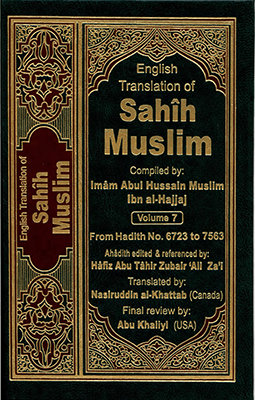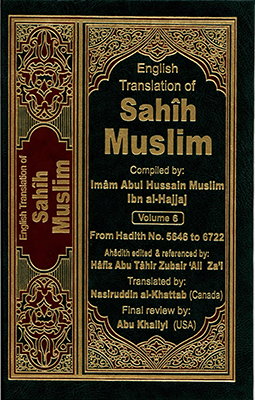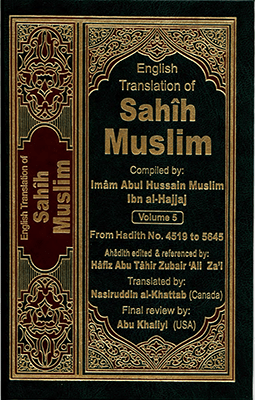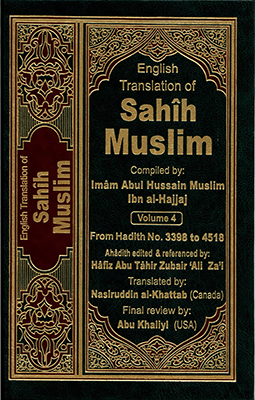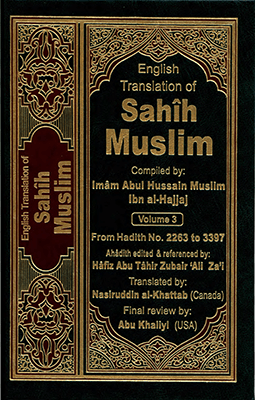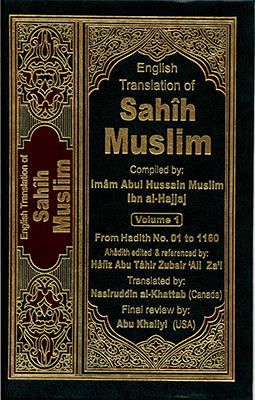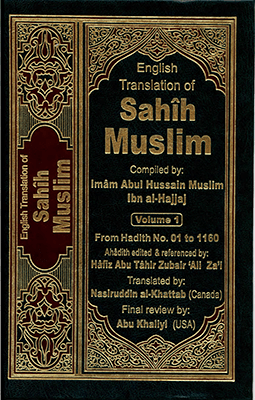Muslim ibn al-Hajjaj

Biography
Al-Imâm, al-Hâfiz, al-Hujjah ‘Abul-Hussain Muslim bin al-Hajjâj bin Ward bin Koshâh al-Qushayri an-Nishâpüri was born in 202 or 204 or 206 AH in Nishãpür and educated in the same town.
His parents were religiously minded people and as such he was brought up in a pious atmosphere. This left such an indelible impression on his mind that he spent the whole of his life as a God-fearing person and always adhered to the path of Righteousness. His excellent moral character can be well judged from the simple fact that he never indulged in backbiting, a very common human failing.
Seeking Knowledge
He heard Ahâdith the first time, at age eighteen, from Yahya bin Yahya Tamimi. In 220 AH he went on pilgrimage to Makkah where he heard Ahadith from ‘Abdullâh bin Salamah Qa’nabi, the most revered pupil of Imâm Mâlik and the principal teacher of Imâm Muslim. In Küfa, he heard Ahâdith from Ahmad bin Yüsuf and a host of other teachers. In addition, he also heard from nearly 220 teachers in Makkah, al-Madinah, ‘Iraq and Egypt. The system of hearing Ahâdith in those times consisted in hearing and writing down Ahâdith along with their chains of narration.
His Teachers
Among the renowned teachers of Muslim were al-Imâm Ahmad bin Hanbal, Ahmad bin Mundhir Qazzâz, Ishâq bin Rahwiyah, Ibrâhim bin Sa’eed Jawhari, Ibrâhim bin Müsâ, Abu Ishâq Râzi, Ahmad bin Ibrâhim, Ishâq bin Müsâ Ansâri (Abü Mâsâ) Ismâ’il bin Abü Uwais, Harmala bin Yahya (Abu Hafs TajIbI) Hasan bin Rabi’ Burâni, Abü Bakr bin Abu Shaiba, Ya’qüb bin Ibrâhim Dawraqi, Abü Zur’ah Râzi, Yahya bin Ma’een and other Huffâz.
His Relationship with Imam Bukhari
Having finished his studies, he settled down at Nishapur. There he came into contact with Imam Bukhari, and was so much impressed by his vast knowledge of Hadith and his deep insight into it that he kept himself attached to him up to the end of his life. He was an ardent admirer of another great-teacher of Hadith, Muhammad ibn Yahya adh-Dhuhli and attended his lectures regularly, but when the difference of opinion between Muhammad bin Yahya and Imam Bukhari, on the issue of the creation of the Holy Qur’an, sharpened into hostility, Imam Muslim sided with Imam Bukhari and abandoned Muhammad bin Yahya altogether. He was thus a true disciple of Imam Bukhari.
His Sahih
He wrote many books and treatises on Hadith, but the most important of his works is the collection (Jami’) of his Sahih Some of the commentators of Ahadith are of the opinion that in certain respects it is the best and most authentic work on the subject. Imam Muslim took great pains in collecting 300,000 Traditions, and then after a thorough examination of them retained only 4000, the genuineness of which is fully established.
He prefixed to his compilation a very illuminating introduction, in which he specified some of the principles which he had followed in the choice of his material.
His Students
Imam Muslim had a very wide circle of students, who learnt Hadith from him. Some of them occupy a very prominent position in Islamic history, e.g. Abu Hatim Razi, Musa ibn Harun, Ahmad bin Salama, Abu ‘Isa Tirmidhi, Abu Bakr ibn Khuzaymah, Abu ‘Awana and Hafidh adh-Dhahabi.
His Death
The circumstances of his death, as recorded in Târikh Baghdad and Sira A’lâm an-Nubalâ’, are very strange indeed, and show his excessive passion for the science of Hadith and his inordinate zeal for inquiry and research in this field. According to Ahmad bin Salamah, a gathering was held to benefit by the knowledge of Imâm Muslim. There he heard a Hadith which he had not heard before. When he came back home, he lit a lamp and told his family not to allow anyone to enter his room. His family told him about a gift they had received, a basketful of dates. He told them to bring it to him. Immersed in his search for that particular Hadith, he kept on eating the dates, one by one, while he was absorbed in his search for the Hadith. By early morning, he found the Hadith but the basket was empty. It was for this reason, it is said, that he fell sick and died.
Written Works
The following are the important works of Imâm Muslim as mentioned by Hâkim and other Hadith scholars:
1. Al-Asâmi wal kunâ
2. Kitâb At-Tabaqât
3. Kitâb Al-Wahdân
4. Kitâb Al-Afrâd
5. Kitâb Al-Aqrân
6. Kitâb Awlâd As-Sahâbah
7. Kitâb Afrâd Ash-Shâmiyyin
8. Kitâb Mashâikh Mâlik
9. Kitâb Mashâikh Ath-Thawri
10. Kitâb Mashâ’ikh Shu’bah
11. Kitâb Man Laisa Lahu Al-Irawin-Wahid
12. Kitâbul-MukhadoramIn
13. Kitâb Tabaqât At-Taba’In
14. Kitâb Al-Musnad al-Kabir ‘Ala ar-Rijâl
15. Kitâb Al-jâmi’ ‘Alal-Abwâb
16. Kitâbul-Musnad As-SahIh
17. Kitâb Hadith ‘Amr bin Shu’aib
18. Kitâb At-Tamyiz
19. Kitâbul-‘Ilal
20. Kitâb Suwâlât Ahmad bin Hanbal
21. Kitâb Awhâm Al-Muhaddithin
22. Kitâb Al-Intifâ ‘Bi Ahbis-Sabâ’
The foregoing are the important works of Imâm Muslim, not a complete list of his writings.
Adapted from [Sahih Muslim Vol. 1 pp 27-29] & http://www.sunnah.org/history/Scholars/Imam_muslim.htm


